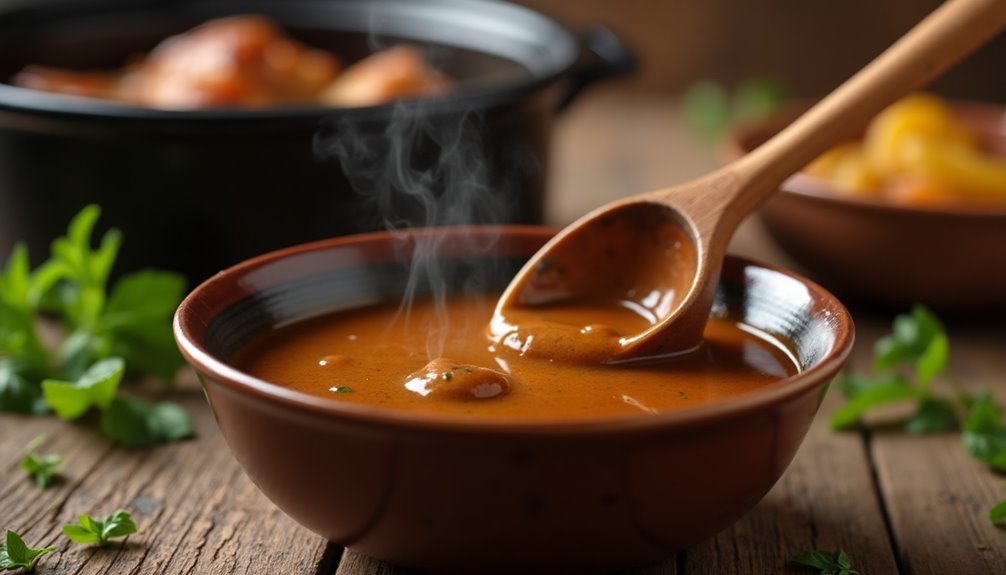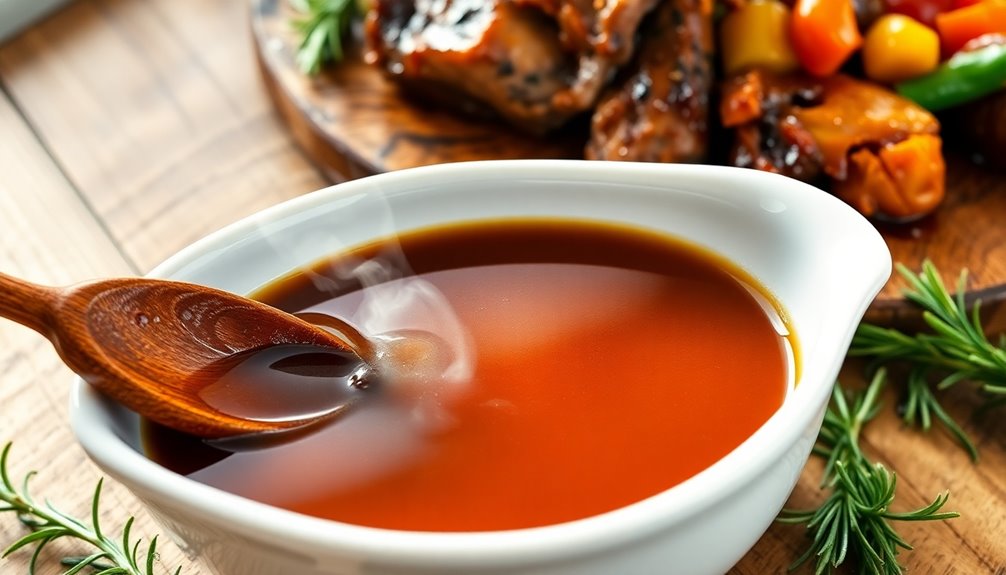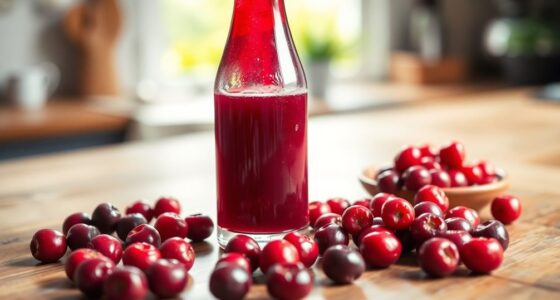To make gravy from your crock pot roast juice, start by transferring at least 3 cups of hot roast juice to a saucepan. Melt 2 tablespoons of butter, whisk in an equal amount of flour to create a roux, and cook for about a minute. Gradually whisk in the roast juice until smooth, then let it simmer for 4-5 minutes to thicken. Season with salt and pepper, and you'll soon be drenching your meal in delicious gravy. There's more to explore!
Key Takeaways
- Transfer at least 3 cups of hot roast juice from the slow cooker to a saucepan for maximum flavor.
- Create a roux by melting 2 tablespoons of butter and whisking in an equal amount of flour until smooth.
- Gradually whisk hot roast juice into the roux to avoid lumps and achieve a smooth gravy consistency.
- Simmer the gravy for 4-5 minutes to thicken, adjusting with flour or a cornstarch slurry if needed.
- Season the gravy with salt and pepper before serving over pot roast, mashed potatoes, or roasted vegetables.

Making gravy from roast juice is a simple way to elevate your meal and add rich flavor to your dishes. If you've just finished cooking a delicious pot roast in your slow cooker, you've got the perfect base for an incredible gravy. The drippings left behind are packed with flavor, and with just a few steps, you can transform them into a velvety sauce that complements your roast and sides perfectly.
Start by transferring at least 3 cups of the roast juice from your slow cooker into a saucepan. This will be the foundation of your gravy. It's essential to use the drippings since they carry all the savory goodness of the roast.
Next, create a roux, which is the secret to a thick and creamy gravy. Melt 2 tablespoons of butter in the saucepan over medium heat. Once the butter's melted and bubbling, whisk in an equal amount of flour until it's fully combined. You want to cook this mixture for about a minute to eliminate the raw flour taste and enhance the flavor of your gravy.
Now, it's time to incorporate the hot roast juices into your roux. Gradually pour the roast juice into the saucepan while whisking continuously. This motion will help you avoid lumps, resulting in a smooth consistency. It's important to add the liquid slowly, allowing the roux to absorb it gradually. As you whisk, you'll notice the mixture starting to come together beautifully, creating a luscious base for your gravy.
Once you've added all the roast juice, let the gravy simmer for about 4-5 minutes. This simmering time is crucial as it allows the gravy to thicken to your desired consistency. If you find the gravy isn't thickening as much as you'd like, you can easily adjust it by adding a little more flour or a cornstarch slurry. Just mix a tablespoon of cornstarch with cold water and stir it into the simmering gravy for an instant thickening boost.
Before serving, don't forget to season your gravy to taste with salt and pepper. The seasoning will bring out the flavors even more, making it irresistible.
Now you're ready to pour your homemade gravy over the pot roast and mashed potatoes, creating a delicious meal that everyone will love. Feel free to drizzle some gravy over roasted vegetables too; it's an excellent way to tie all the flavors together.
With this method, you can confidently make gravy from your slow cooker's roast juice, ensuring every meal is a delightful experience. Enjoy the compliments that come your way as your family savors each bite!
Frequently Asked Questions
Can You Make Gravy From Slow Cooker Juices?
Yes, you can definitely make gravy from slow cooker juices!
After cooking, you'll find flavorful drippings in the pot that are perfect for gravy. Just transfer about 3 cups of those drippings to a saucepan and heat them up.
You can create a roux by melting some butter and whisking in flour, then gradually add the hot drippings.
Cook and whisk until it thickens, adjusting the seasoning to taste. Enjoy your delicious homemade gravy!
How to Make Roast Juice Into Gravy?
Picture a chef in a bustling kitchen, transforming simple ingredients into a savory masterpiece.
To make roast juice into gravy, start by collecting those rich drippings. Melt butter in a saucepan, whisk in flour to create a roux, then gradually add the hot juices, whisking constantly. Allow the mixture to simmer until it thickens to your desired consistency, often just a few minutes. If you want to enhance the flavor further, consider adding herbs or spices that complement your dish. For those curious about how to use pot roast juice, drizzling it over mashed potatoes or incorporating it into a stew can elevate your meal significantly.
Let it bubble and thicken, stirring frequently. Adjust the seasoning, and you've got a luscious gravy that elevates your meal, just like a chef's secret ingredient!
How Do You Thicken Crock Pot Juice for Gravy?
To thicken crock pot juice for gravy, you've got a couple of great options.
Create a roux by mixing equal parts flour and butter, cooking it until golden before adding it to the juices.
Alternatively, mix 1 tablespoon of cornstarch with 1 tablespoon of cold water, then whisk it into the hot juices until you reach your desired thickness.
Just remember to heat the juices first to avoid clumping!
What Can I Do With the Liquid From a Pot Roast?
You can do a lot with the liquid from a pot roast! First, strain it to remove any solids, then use it as a flavorful base for soups or stews.
You can also drizzle it over cooked grains like rice or quinoa for extra taste. If you want, try reducing it into a sauce, or even use it in marinades to infuse your dishes with that rich, savory flavor.
Enjoy experimenting!
Conclusion
Now that you've transformed those savory juices into a delightful gravy, it's time to elevate your meal to new heights. Just like a warm blanket on a chilly day, this rich sauce wraps your roast in comfort, enhancing every bite. Pour it generously over your dish, and watch as it brings everything together in perfect harmony. Enjoy the satisfaction of creating something delicious from your crock pot roast—your taste buds will thank you for it!
Cindy thoroughly researches juicing trends, techniques, and recipes to provide readers with practical advice and inspiration. Her writing style is accessible, engaging, and designed to make complex concepts easy to understand. Cindy’s dedication to promoting the advantages of juicing shines through her work, empowering readers to make positive changes in their lives through the simple act of juicing.











